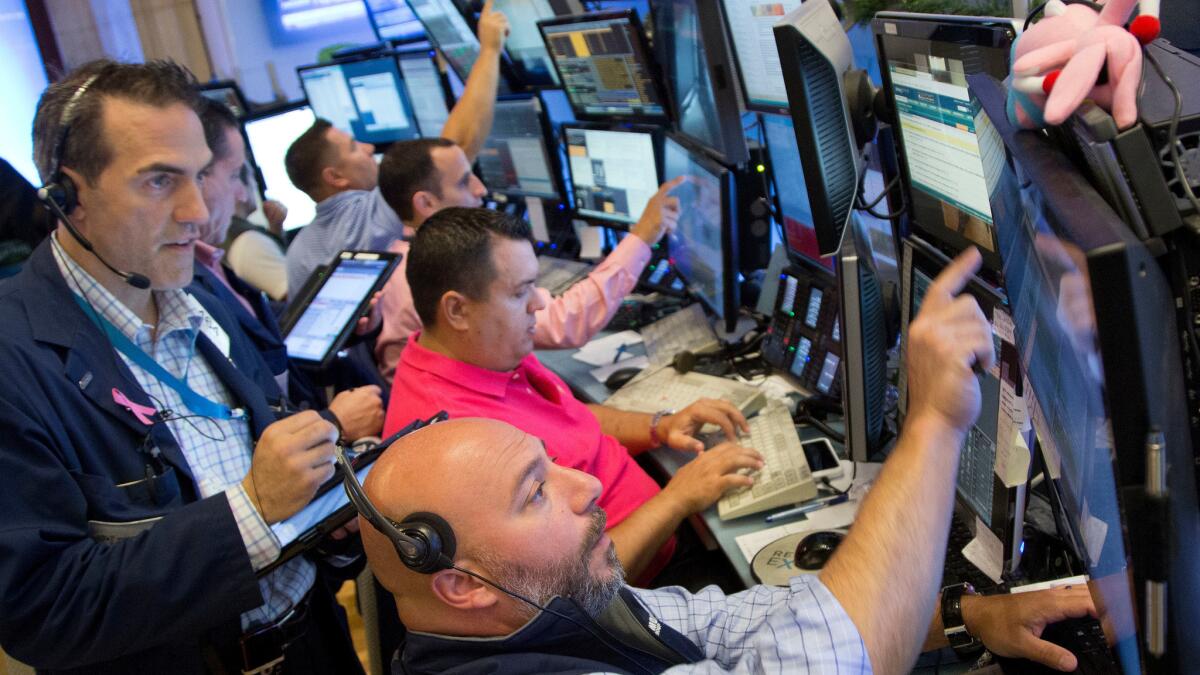Stocks creep up, setting another record high

Another day, another lazy drift higher for stocks and another record high.
The Standard & Poor’s 500 index rose 9.86 points, or 0.5%, to 2,175.03 on Friday. It surpassed its prior record set Wednesday by 0.09%, the latest nudge higher for a market that has taken a slow and steady path to all-time highs in recent weeks. Telecom and utility stocks led the way, as they have for much of this year.
The Dow Jones industrial average rose 53.62 points, or 0.3%, to 18,570.85. The Nasdaq composite rose 26.26, or 0.5%, to 5,100.16. The gains sent all three indexes to their fourth consecutive winning week, their longest streak since March.
Many doubts still hang over the market, including the continued drop for corporate earnings and a U.S. economy that is growing only modestly. But various earnings and economic reports have come in better than expected, and the S&P 500 is up nearly 9% since June 27.
Southwestern Energy jumped 9.5% to $14.47, the biggest gain in the S&P 500, on its own better-than-expected earnings report. It lost money in the latest quarter but less than analysts estimated. The producer of natural gas and oil also raised its forecast for production this year.
American Airlines Group likewise rose despite reporting a drop in earnings. Shares climbed 4% to $36.36 after the company posted better results than analysts expected.
California firms making big moves included Skechers USA, which plunged 22.3% to $24.99 after the Manhattan Beach shoe company reported profit and sales that were far smaller than expected.
Proofpoint jumped 10.5% to $72.15 after the Sunnyvale, Calif., data security company reported a surprise profit and better sales than expected and raised its projections for the year.
The telecom and utilities sectors each rose 1.3% to lead the market. They have been at the forefront of the market’s rise this year because they pay some of the biggest dividends, and investors are scrounging for income given the low interest rates paid by bonds.
The yield on the 10-year Treasury note held steady at 1.56%, and the yield on the 30-year Treasury bond ticked down to 2.28% from 2.29%.
Honeywell International fell 2.6% to $115.61 after reporting stronger earnings than analysts expected but also lowering its forecast for full-year sales. That helped hold the industrial sector to the weakest gains of the day among the 10 sectors that make up the S&P 500, up 0.1%.
Friday’s gains were the latest in a steady march higher for stocks. The S&P 500 has not had a day when it moved by 1%, up or down, in the last two weeks. It’s a sharp turnaround from the end of June, when worries about Britain’s vote to leave the European Union sent the S&P 500 to six straight days when it swung at least 1%.
The biggest loss for the S&P 500 over that span was Thursday’s drop of 0.4%. And investors quickly snapped up stocks the following day.
“I think people are a little more sensitized, where any tick lower in the market creates this ‘buy on the dip’ mentality,” said Brian Jacobsen, chief portfolio strategist at Wells Fargo Funds Management. “I think it’s interesting; a half-a-percent move down feels like a 5% move.”
Next week could be more exciting. The Bank of Japan and Federal Reserve both hold policy meetings. Record-low interest rates and big stimulus programs from central banks have pushed stocks higher since the financial crisis.
Japan’s economy is barely growing. Economists are speculating about whether its central bank may push more stimulus next week.
The U.S. economy is in better shape than other advanced economies, and few expect the Federal Reserve to make a big move at its meeting. But if the Fed highlights the better-than-expected recent economic reports, economists may move up their predictions for when it could next raise interest rates.
The Fed pulled rates off their record low in December but has held pat since then.
European stock markets were mixed. Germany’s DAX index slipped 0.1%; France’s CAC 40 index rose 0.1%; and Britain’s FTSE 100 rose 0.5%. Japan’s Nikkei 225 index fell 1.1%; Hong Kong’s Hang Seng slid 0.2%; and South Korea’s Kospi index lost 0.1%.
The price of U.S. crude fell 56 cents, or 1.2%, to $44.19 a barrel. Brent crude, the global benchmark, fell 51 cents, or 1.1%, to $45.69 a barrel. Wholesale gasoline rose 1 cent to $1.36 a gallon; heating oil fell 1 cent to $1.36 a gallon; and natural gas rose 9 cents to $2.78 per 1,000 cubic feet.
Precious and industrial metals prices ended lower. Gold fell $7.60 to $1,323.40 an ounce; silver fell 13 cents to $19.69 an ounce; and copper lost 2 cents to close at $2.24 a pound.
The pound sank against the dollar on expectations for more stimulus from the Bank of England. It fell to $1.3093 from $1.3203. The dollar ticked up to 106.17 Japanese yen from 105.86 yen, and the euro dipped to $1.0961 from $1.1013.
UPDATES:
3 p.m.: This article was updated with information about Skechers USA and Proofpoint.
2:25 p.m.: This article was updated with closing prices and additional information.
12:30 p.m.: This article was updated with more recent prices.
7:40 a.m.: This article was updated with additional details.
This article was originally published at 7 a.m.






